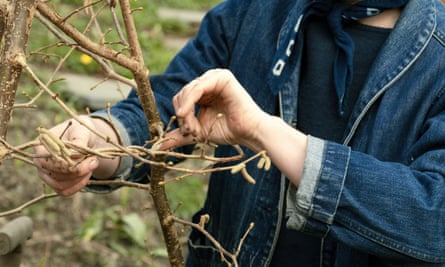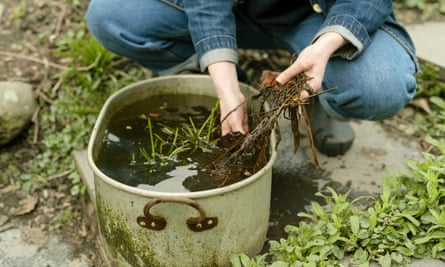Empty your compost bins
Before all the soil disappears under new growth, empty your compost bins and spread out the contents as a mulch. A winter of being slowly digested should mean the contents have rotted down deliciously to dark, soft, rich matter. But it may be a case of sieving the good from the not yet there – large twigs, eggshells, things that take longer to break down. Once you’ve got the good stuff out, use it as mulch on bare soils around emerging perennials, shrubs, fruit bushes and trees.

It can also be used to top-dress pots, containers and window boxes. It will act as spring boost, feeding new growth and stopping weed seeds from germinating. Importantly, organic matter will improve the soil’s ability to deal with both rain or drought. Whatever the summer brings, homemade compost remains the best tool to fight it.
Beat the flop

On the subject of bare ground, get staking quick, before new growth swallows up space and rain makes your plants flop. Locally coppiced hazel makes for beautiful, sustainable structures; and the twiggy stuff makes perfect pea sticks for dwarf peas, peonies, geraniums and other climbers; the bean poles are ideal for taller plants, clematis, beans, peas, sweet peas and pumpkin. The National Coppice Federation will help you find local coppiced poles and sticks.
Love your pond

If you have a pond, I hope it is full of frog or toad spawn (or both if you’re lucky). If it isn’t, is it because it needs a little TLC? Did it fill up with autumn leaves and is actually more of a puddle? Remove all the rotten, dead and dying leaf matter. Initially let it drain off by the side of the pond so anything that is capable of climbing back into the water can. Ideally top it up with rainwater – either from a water butt or wait until it rains – rather than using treated water from the hose.
If you don’t have a pond, how about making one? Even a container pond the size of bucket can make a huge difference to wildlife, and it’s a perfect Saturday afternoon project. Add a few stones, a brick, some twigs leaning up the side so frogs and insects can clamber in and out. Plants are important for the balance of the pond’s ecosystem: miniature water lilies, water spearmint, brooklime, and the culinary herb fish mint – Houttuynia cordata ‘Chameleon’, which is similar to coriander with a citrus hit – are all ideal for smaller ponds.
Take dahlia cuttings
Do you dream of a garden full of dahlias, but don’t want to spend cash on all those fat tubers? Take cuttings now. This method is particularly useful for the really big blousy varieties because they produce a lot of new shoots, and if you leave all these shoots on, you tend to get a rather top-heavy plant that needs a lot of staking come summer.
By removing some of the shoots so that you just have three or perhaps four per tuber, you also concentrate the growth into better flower production. The spare shoots that you remove will root easily and flower this summer. Each shoot needs to be cut off with a little heel of tuber so that it roots quickly. Sarah Raven, queen of dahlias, has a really good online video showing exactly how to do this.
Move your perennials
While the soils are wet with spring rains, but warm with possibilities, take the opportunity to move perennials that may be in the wrong place. There are always one or two plants that you hastily chuck in a space, then realise it is not right. Move them now and I promise they will bed down quickly and not mind too much. Wait a month and they will sulk or do far worse because the temperature will have soared and the soils dried out before they had time to put down new roots.

It is, however, too late to move trees and shrubs – that had to happen over winter – or anything that is just coming into flower, such as pulmonarias and brunneras. It’s better to move these after they’ve flowered in early June. If it doesn’t rain after replanting, water regularly till you see new growth, which is a sign that roots have bedded down.
Get more plants for free
While you’re moving things around, divide large clumps of summer-flowering perennials, such as geraniums, delphiniums, ornamental grasses, salvias, Sedum and daylilies. The easiest way is to dig up the plant, then either divide it into two or slice off several decent-sized sections. Make sure each section has a good ratio of roots to shoots. A certain amount of repetition is key to a good design, as your eye floats from one place to the next through such movement; dividing what’s currently doing well in your garden is an easy, free way to achieve this.

Buy plants for less
If you can move or divide perennials you can, of course, plant them. March is the final month of bare root plants. As the name suggest, plants come without any soil. At this point the plant is still dormant, so it doesn’t mind being dug up and moved. It’s less laborious for the grower to send plants this way and also has less environmental impact.
But time is ticking: orders need to be in swiftly, because growers won’t send out plants after the end of March.
Sow everything

Now is the time for sowing. But if it’s the least bit cold, wait on direct sowing till the end of this month: it makes such a big difference to success if the soil is warm. If the soil feels cold to touch with ungloved hand, don’t sow.
However, a few things will soldier on regardless of the temperature. Sow broad beans, peas, radishes and sweet peas directly into either pots or the ground.
If you have open packets of hardy annuals such as poppies, calendula, nigella and wildflower mixes, sow on bare ground now. Pretty much everything else I sow in modules, which I keep somewhere protected, either a greenhouse, polytunnel, cold frame or cool window sill until the soil is truly warmed.

Comments (…)
Sign in or create your Guardian account to join the discussion